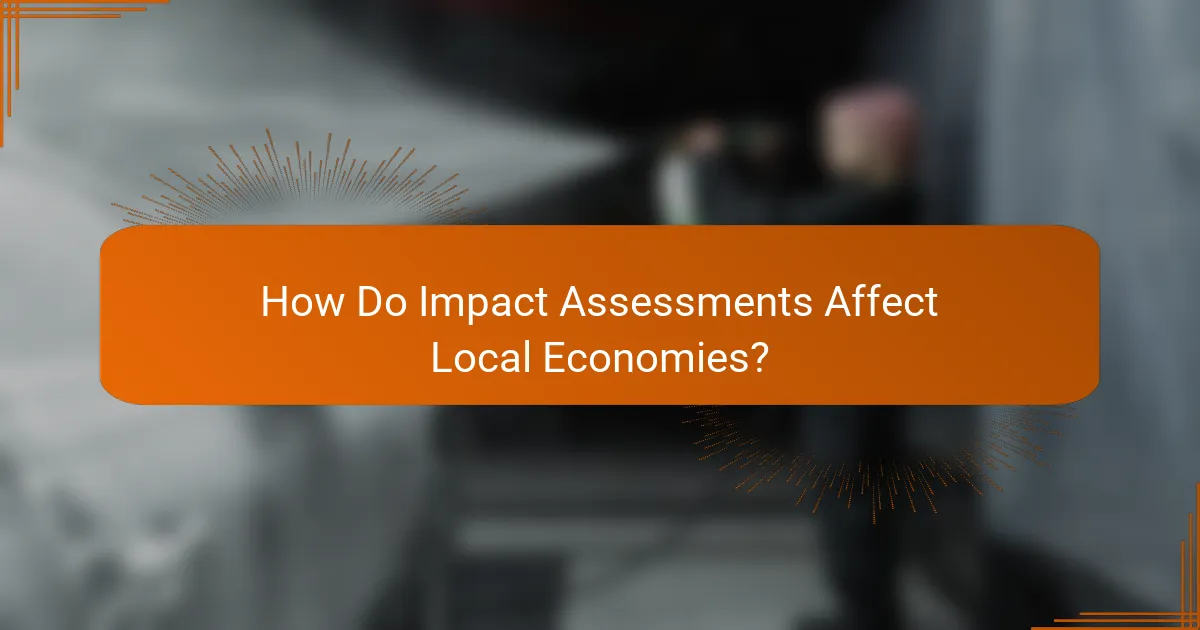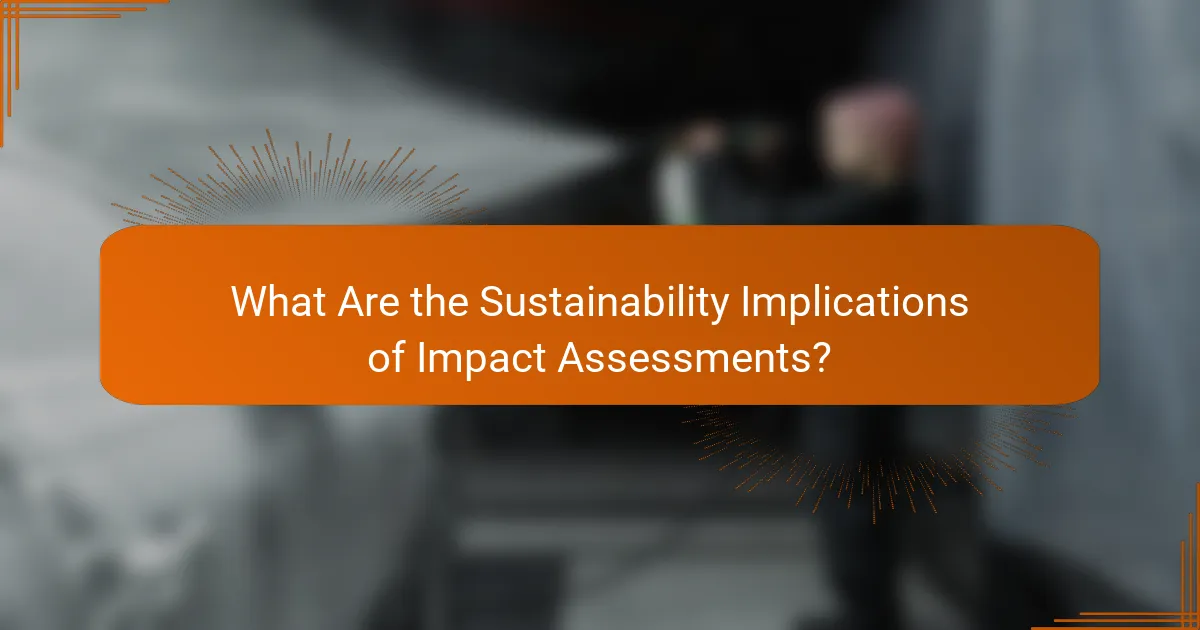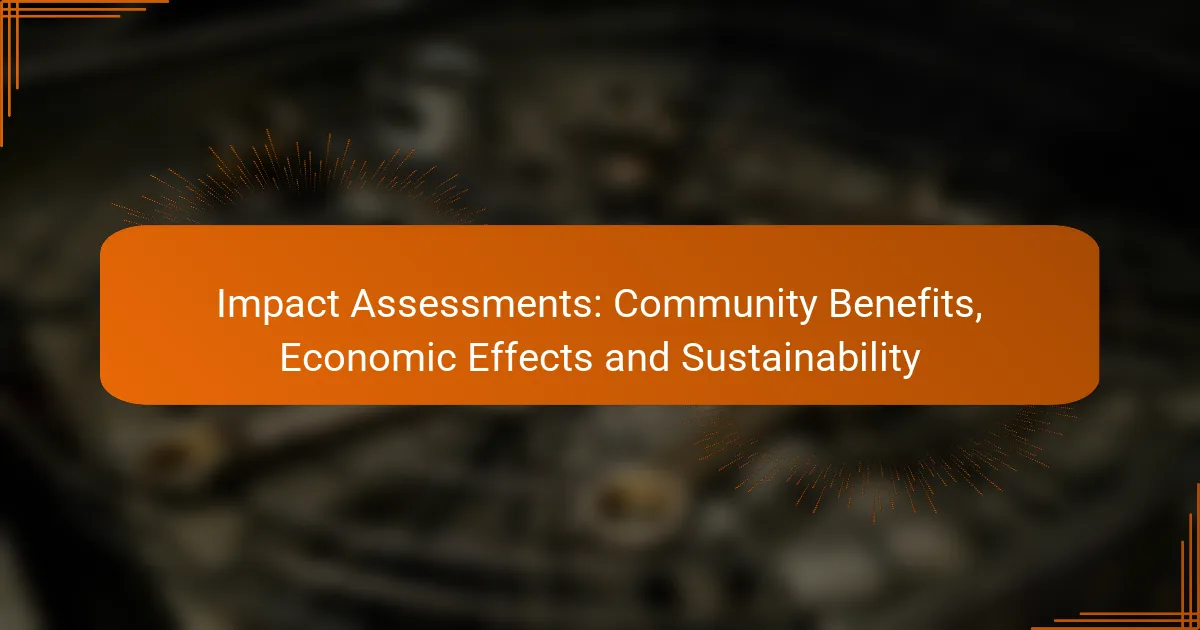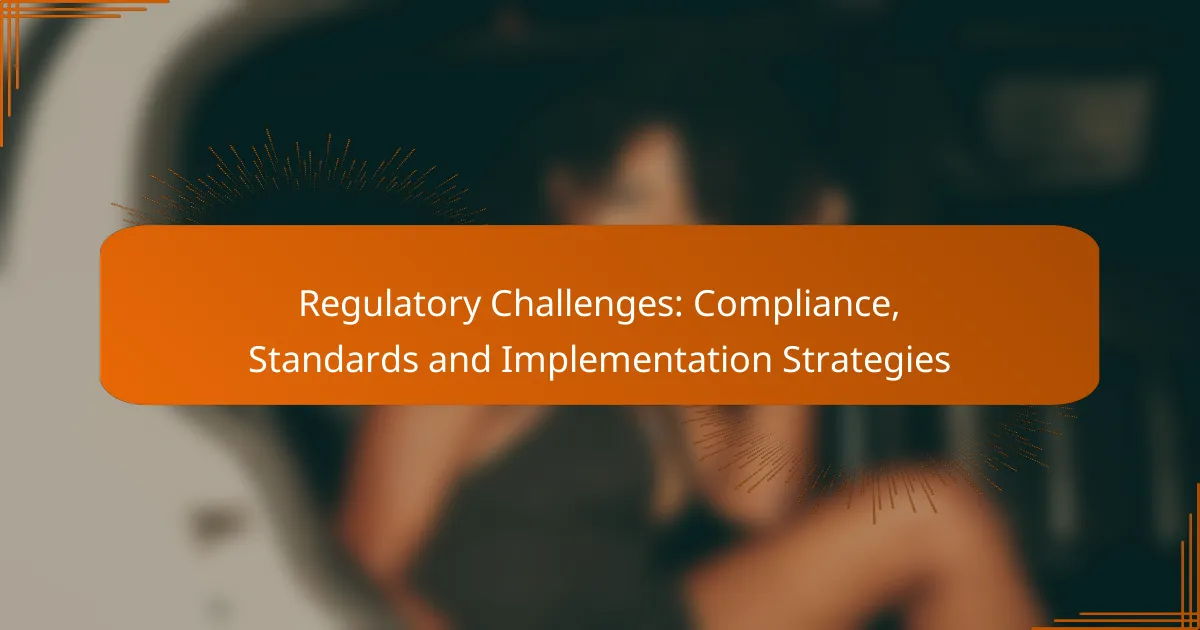Impact assessments play a crucial role in evaluating the potential effects of projects on communities, ensuring that both positive and negative impacts are considered. By prioritizing community needs, these assessments contribute to sustainable development and improved quality of life. Additionally, they provide insights into economic implications, helping stakeholders understand how developments can foster job creation and attract investment while promoting environmental sustainability.

What Are the Community Benefits of Impact Assessments?
Impact assessments provide significant community benefits by identifying potential positive and negative effects of projects on local populations. These assessments help ensure that community needs are prioritized, leading to improved quality of life and sustainable development.
Enhanced public health
Impact assessments can lead to enhanced public health by identifying potential health risks associated with new projects. By evaluating factors such as air and water quality, noise pollution, and access to healthcare facilities, communities can implement measures to mitigate negative health outcomes.
For instance, a proposed industrial facility might be assessed for its emissions, prompting the implementation of stricter regulations to protect nearby residents. This proactive approach can lead to healthier living conditions and reduced healthcare costs over time.
Improved social cohesion
Impact assessments foster improved social cohesion by involving community members in the decision-making process. Engaging residents in discussions about potential projects helps build trust and encourages collaboration among diverse groups.
When communities feel heard and valued, they are more likely to support local initiatives, leading to stronger relationships and a sense of belonging. This can be particularly beneficial in areas with diverse populations or historical tensions.
Increased community engagement
Increased community engagement is a direct benefit of impact assessments, as they provide opportunities for residents to voice their concerns and suggestions. Public meetings, surveys, and workshops can be organized to gather input from various stakeholders.
Active participation not only empowers residents but also ensures that projects align with community values and needs. This engagement can lead to more successful outcomes and greater public support for initiatives.
Access to resources and services
Impact assessments can improve access to resources and services by identifying gaps in community infrastructure. By analyzing existing facilities and services, planners can propose enhancements or new developments that better serve the population.
For example, an assessment might reveal a lack of public transportation options, prompting the introduction of new routes or services. This can significantly enhance mobility for residents, particularly those in underserved areas.
Environmental preservation
Environmental preservation is a crucial aspect of impact assessments, as they evaluate the potential ecological effects of projects. By identifying sensitive habitats and ecosystems, assessments can guide developers in minimizing environmental harm.
For instance, a project near a wetland may require adjustments to protect local wildlife. Implementing sustainable practices not only benefits the environment but can also enhance community pride and attract eco-conscious residents and businesses.

How Do Impact Assessments Affect Local Economies?
Impact assessments significantly influence local economies by identifying potential benefits and drawbacks of proposed projects. They help stakeholders understand how developments can create jobs, attract investments, and enhance property values, ultimately shaping community growth.
Job creation
Impact assessments often highlight the potential for job creation associated with new projects. By evaluating the types of jobs that may be generated, such as construction, manufacturing, or service roles, communities can better prepare for workforce needs. For instance, a new factory might create hundreds of jobs, benefiting both the local economy and residents seeking employment.
However, it is essential to consider the quality of jobs created. Assessments should evaluate whether these positions offer fair wages and benefits, ensuring that job growth translates into sustainable economic improvement.
Increased local investment
Local economies can see a boost in investment as a direct result of favorable impact assessments. When projects demonstrate clear benefits, such as infrastructure improvements or enhanced public services, they attract both public and private funding. This influx of capital can lead to further developments and economic growth.
Communities should actively engage with investors and stakeholders during the assessment process to ensure that the resulting investments align with local needs and priorities. This collaboration can maximize the positive economic impact of new projects.
Boost in property values
Impact assessments can indicate how proposed developments might affect property values in the surrounding area. Positive assessments often lead to increased demand for housing and commercial spaces, driving up property prices. For example, a new public park or shopping center can make nearby neighborhoods more desirable.
However, rising property values can also lead to challenges, such as affordability issues for current residents. Communities should consider strategies to mitigate negative effects, ensuring that growth benefits all residents.
Support for local businesses
New developments assessed positively can provide significant support for local businesses by increasing foot traffic and consumer spending. For instance, a new retail complex can attract visitors who may also shop at nearby stores, creating a ripple effect of economic benefits.
It’s crucial for impact assessments to include evaluations of how new projects will interact with existing businesses. Engaging local entrepreneurs in the assessment process can help identify opportunities for collaboration and ensure that new developments complement rather than compete with established enterprises.

What Are the Sustainability Implications of Impact Assessments?
Sustainability implications of impact assessments focus on how projects affect environmental health, resource use, and community well-being. These assessments help identify potential negative outcomes and promote practices that enhance ecological balance and resource conservation.
Resource management
Effective resource management is crucial in impact assessments as it ensures that natural resources are used sustainably. This involves evaluating the availability of resources like water, minerals, and forests, and determining how project activities may deplete or degrade these assets.
Stakeholders should consider implementing strategies such as conservation practices, recycling, and efficient resource allocation to minimize negative impacts. For example, a construction project might incorporate rainwater harvesting to reduce water usage.
Long-term environmental benefits
Impact assessments aim to identify long-term environmental benefits that can arise from projects, such as habitat restoration and biodiversity enhancement. By evaluating potential impacts, planners can design projects that not only mitigate harm but also contribute positively to the ecosystem.
For instance, a renewable energy project might lead to the rehabilitation of degraded land, improving local flora and fauna. Such benefits can enhance community resilience and ecological health over time.
Reduction of carbon footprint
Reducing the carbon footprint is a key goal of sustainability in impact assessments. This involves analyzing greenhouse gas emissions associated with a project and finding ways to minimize them through efficient practices and technologies.
For example, a transportation project could incorporate electric vehicles and optimize routes to decrease emissions. Implementing energy-efficient technologies can significantly lower the overall carbon output, contributing to climate change mitigation.
Promotion of renewable energy
Impact assessments often promote renewable energy sources as a sustainable alternative to fossil fuels. By evaluating the potential for solar, wind, or hydroelectric power, projects can align with environmental goals and reduce reliance on non-renewable resources.
Incorporating renewable energy solutions not only decreases carbon emissions but can also lead to cost savings in the long run. For example, a community solar project can provide clean energy while fostering local job creation and economic growth.

What Criteria Should Be Considered in Impact Assessments?
Impact assessments should consider criteria that evaluate community benefits, economic effects, and sustainability. Key factors include stakeholder involvement, regulatory compliance, and effective data collection methods.
Stakeholder involvement
Engaging stakeholders is crucial for a comprehensive impact assessment. This includes local residents, businesses, and government entities who may be affected by the project. Their input can provide valuable insights into community needs and potential concerns.
To ensure effective stakeholder involvement, consider conducting public meetings, surveys, and focus groups. These methods can help gather diverse perspectives and foster a sense of ownership among community members.
Regulatory compliance
Compliance with local, state, and federal regulations is essential in impact assessments. This ensures that the project adheres to legal standards and mitigates potential risks. Familiarize yourself with relevant laws, such as environmental protection regulations and zoning laws.
Regularly review compliance requirements throughout the assessment process. This can help avoid costly delays or legal challenges later on. Consulting with legal experts can also provide clarity on complex regulations.
Data collection methods
Effective data collection methods are vital for accurate impact assessments. Utilize both qualitative and quantitative approaches to gather comprehensive information. Surveys, interviews, and existing data sources can provide a well-rounded view of potential impacts.
When selecting data collection methods, consider the target audience and the type of information needed. For example, community surveys can reveal public sentiment, while economic data can quantify financial impacts. Always ensure data is collected ethically and transparently.

How to Evaluate the Effectiveness of Impact Assessments?
Evaluating the effectiveness of impact assessments involves analyzing their ability to accurately predict community benefits, economic effects, and sustainability outcomes. Key factors include stakeholder engagement, data quality, and the assessment’s alignment with local regulations and community needs.
Community Benefits
Community benefits refer to the positive outcomes that impact assessments aim to deliver to local populations. These can include improved public services, enhanced infrastructure, and increased access to resources. To evaluate these benefits, consider both qualitative feedback from community members and quantitative measures such as changes in employment rates or access to healthcare.
Engaging with community stakeholders during the assessment process is crucial. This ensures that the identified benefits align with the actual needs and priorities of the community. Regular follow-ups after the implementation of projects can help gauge the long-term impact of these benefits.
Economic Effects
The economic effects of impact assessments encompass changes in local employment, business growth, and overall economic activity. To evaluate these effects, analyze data on job creation, investment levels, and local business performance before and after project implementation. Economic modeling tools can also provide insights into potential long-term impacts.
Consider the broader economic context, such as regional economic conditions and industry trends. This helps in understanding how external factors may influence the outcomes of the impact assessment. It is important to communicate these findings clearly to stakeholders to ensure transparency and trust.
Sustainability
Sustainability in impact assessments focuses on the long-term viability of environmental, social, and economic benefits. Evaluating sustainability involves assessing resource use, environmental impact, and social equity over time. Key indicators may include carbon emissions, water usage, and community resilience.
Incorporating sustainability metrics into the evaluation process can help identify potential trade-offs and synergies among different impact areas. Regular monitoring and reporting on sustainability outcomes are essential for adapting strategies and ensuring that projects remain aligned with sustainability goals.



